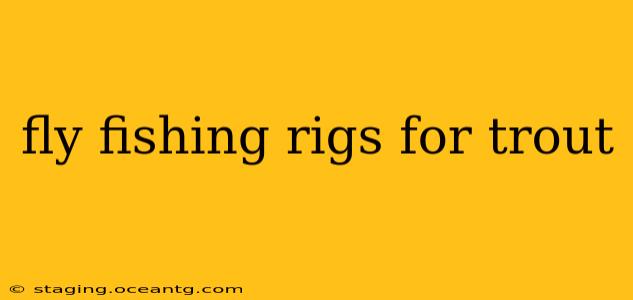Fly fishing for trout is a rewarding pursuit, demanding skill, patience, and the right equipment. Choosing the appropriate rig is crucial for success, as different situations call for different approaches. This comprehensive guide explores various fly fishing rigs for trout, helping you select the best setup for your next angling adventure. We'll cover everything from basic setups to more advanced techniques, ensuring you're well-equipped to land that trophy trout.
What are the different types of fly fishing rigs?
Before delving into specific trout rigs, let's understand the basic components. A fly fishing rig typically consists of:
- Fly Rod: The length and weight of your rod will depend on the size of the trout you're targeting and the type of water you're fishing.
- Fly Reel: A smooth-functioning reel is essential for proper line management.
- Fly Line: The weight of your fly line must match your rod. Different lines (floating, sinking, etc.) are used for various fishing techniques.
- Leader: A tapered leader connects your fly line to your fly, creating a more natural presentation.
- Tippet: The lighter material attached to the end of the leader, directly connecting to the fly.
What is the best fly fishing rig for trout?
There isn't a single "best" rig, as the ideal setup depends heavily on factors like:
- Water Type: Stillwater lakes require different rigs than fast-flowing rivers.
- Trout Species: Different trout species exhibit varying feeding behaviors.
- Fly Size and Type: Larger flies might need heavier tippets and leaders.
- Water Depth: Sinking lines are necessary for deeper waters.
However, several popular and effective rigs stand out for trout fishing.
What is a dry fly rig for trout?
Dry fly fishing involves presenting a dry fly on the surface of the water. This is a classic and highly rewarding technique. A simple dry fly rig consists of:
- Floating Fly Line: This keeps your fly on the surface.
- 7-9ft Leader: Provides a delicate presentation.
- Lightweight Tippet (4x-6x): Offers minimal resistance to the delicate dry fly.
This setup works best in calm waters where trout are actively feeding on surface insects.
What is a nymph rig for trout?
Nymphing involves presenting a fly beneath the surface, mimicking aquatic insects. Several nymph rigs exist, including:
- Euro Nymphing Rig: This highly effective technique uses a short leader and a weighted nymph to quickly cover water. It typically employs a tight line and indicator system.
- Traditional Nymphing Rig: This uses a longer leader with one or more nymphs, often with a strike indicator to detect takes.
Nymphing is especially effective in rivers and streams with faster currents.
What is a wet fly rig for trout?
Wet fly fishing involves retrieving a submerged fly, simulating insects drifting underwater. This rig is often similar to the nymphing rig but might utilize different fly patterns designed for a specific retrieving motion. Experimenting with varying retrieval speeds and techniques is crucial.
What is a streamer rig for trout?
Streamer fishing uses larger, more lifelike flies that imitate smaller fish or baitfish. Streamers are often fished on sinking lines or with weighted heads to cover deeper water.
This technique excels in deeper pools and areas with cover.
How do you choose the right fly for your trout rig?
Fly selection is just as crucial as the rig itself. Consider:
- Matching the Hatch: Observing the insects on or near the water and selecting a fly that mimics them is fundamental.
- Water Conditions: Turbid water might call for more visible flies, while clear water allows for more subtle presentations.
- Trout Behavior: Aggressive trout might respond to larger, bolder flies, while cautious trout may prefer smaller, more natural-looking patterns.
What are some common problems with trout fishing rigs?
- Tangled Lines: Careful line management is crucial, especially with multiple flies or complex rigs.
- Incorrect Leader Length: Too short a leader can spook fish, while too long can hinder casting accuracy.
- Inadequate Tippet Strength: Using tippet too light for the size of the trout can lead to breakoffs.
Mastering trout fishing requires practice and experimentation. Start with simpler rigs and gradually move to more advanced setups as you gain experience and confidence. Remember to always practice catch and release to preserve the trout population for future generations.
